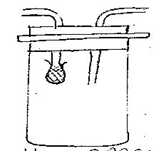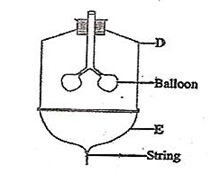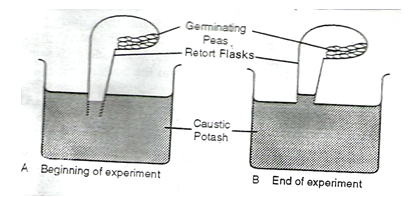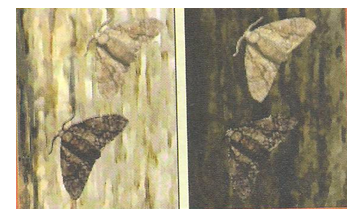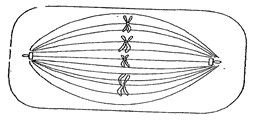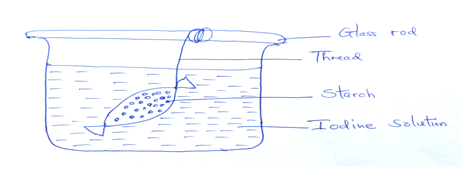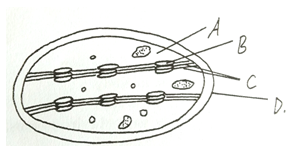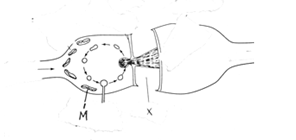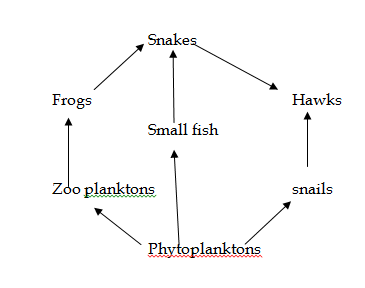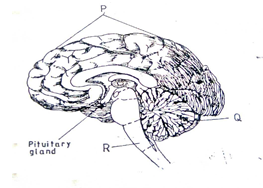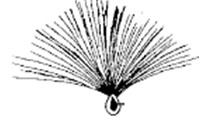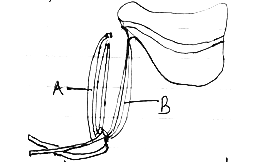Attempt all questions in the spaces provided.
- The diagram below shows apparatus used in biological study.
State its function. (1 mark)
- Name the blood vessel that supplies:
- The heart with nutrients. (1 mark)
- The foetus with oxygen. (1 mark)
- Explain why it’s important to stain specimen to be observed under a light microscope. (1 mark)
- The diagram below represents a model used to demonstrate breathing in mammals.
- Name the mammalian structure represented by parts labeled D. (1 mark)
- What is the effect of contraction of the part labeled E during breathing in a mammal? (3marks)
- State the significance of the following steps while testing for disaccharide in food sample.
- Addition of dilute hydrochloric acid. (1mark)
- Addition of sodium bicarbonate. (1mark)
- Form 2 students from samba secondary school set up an experiment as shown below.
Explain the change observed at the end of the experiment. (1mark)
- State two advantages of metamorphosis to the life cycle of insects. (2marks)
- The photographs below are of organisms resting on different environmental backgrounds. Observe them and answer the questions that follow;
- Name the aspect of evolution depicted in the photograph (1mark)
- Explain the phenomenon. (2marks)
- The diagram below represents a stage in cell division.
- Identify the stage of cell division (1mark)
- Give a reason for your answer (1mark)
- Explain the role of the following hormone in homeostasis
- Insulin ( 2marks)
- Aldosterone hormone when there is less water in blood stream. (1mark)
- Outline three difference between plant divisions Bryophyta and Pteridophyta. (3marks)
- Name two products of light stage of photosynthesis that are useful in light independent stage.(2marks)
- State two functions of xylem tissue. (2marks)
- A student measured the length of a mitochondrion on a photomicrograph whose magnification was X 40000 found it to be 1mm. calculate the actual size of mitochondrion (2marks)
- Form one student set up an experiment shown below to investigate a certain physiological process. The set up was left for 30 minutes.
- State the expected results after 30 minutes (1mark)
- Explain your answer in (a) above (2marks)
-
- Define the term mutation (1mark)
- Name two sex – linked traits in humans attached to Y- chromosomes (2marks)
- The diagram below represents a section through a chloroplast as seen under the electron microscope
- Name the structure labeled D (1mark)
- In which labelled structure do we find chlorophyll molecule (1mark)
- Name the structure labeled, where carbon (IV) oxide fixation occurs (1mark)
-
- State the significance of respiratory quotient (R.Q) values to a biologist (1mark)
- The equation below is a respiratory reaction of a certain substrate. Study it and use it to determine its R.Q value. (1mark)
C20 H40 O20 + 20 O2 →20 CO2 + 20H2O + Energy
- The diagram below represents a specialized plant structure
- Name the cell labelled G. (1 mark)
- State the adaptation of cell E to its function (1mark)
- State the economic importance of the following excretory products in plants (2marks)
- Nicotine
- Quinine
- The diagram below represents a synapse.
- Name the:
- Structure labeled M.(1mark
- Transmitter substance labeled X.(1mark)
- On the diagram, show the direction of the nerve impulse transmission.(1mark)
- Name the:
- The diagram below represents a feeding relationship in an ecosystem.
- Name the type of ecosystem represented by the above food web. (1mark)
- Name the organism in the food web that:
- Are producers (1mark)
- Occupies the highest trophic level (1mark)
-
- Write a food chain that ends with the hawk as quaternary consumer. (1mark)
- State two short term effects on the above ecosystem if all the small fish were killed. (2marks)
- State one way in which oil spills lead to death of fish. (1mark)
- The diagram below represents a section of the human brain.
- Name the structures labelled P and Q. (2marks)
- State one functions of the part labelled (1mark)
- Given below is a diagram of a mature fruit of a certain plant.
- State the agent of dispersal. (1 mark)
- Give a reason for your answer in (i) above. (1 mark)
- State two advantages of fruit and seed dispersal. (2 marks)
- Below is a nucleotide strand.
A
A
G
T
C
- Identify the type of nucleic acid strand. (1 mark)
- Write down the complimentary base sequence in the other strand. (1 mark)
- Study the diagram below and answer the questions that follow.
- Name the muscle labelled: (2marks)
- What happens to each muscle as the arm is straightened? (2marks)
- The binomial name of housefly is MUSCA DOMESTICA.
- State two mistakes in the way the scientific name is written. (2marks)
- Re-write the name in correct manner following the rules of binomial nomenclature. (1mark)
- Below is a photograph of an organism
- Identify the class to which this organism belongs to. (1 mark)
- Give a reason for your answer in (i) above. (1 mark)
- The following table shows the volume of gases carried by 100cm3 of blood.
Gas
Blood entering lungs
Blood leaving lungs
Nitrogen
0.9 cm3
0.9 cm3
Oxygen
10.6 cm3
19.0 cm3
Carbon (IV) oxide
58.0 cm3
50.0 cm3
- Which blood has a higher content of carbon (IV) oxide? (1 mark)
- Explain the difference in the content of oxygen and carbon (IV) oxide in blood entering the lungs and that leaving the lungs. (2 marks)
- State two adaptations of each of the following structures to reproduction in animals.
- Oviduct (2 marks)
- Epididymis (2 marks)
Download BIOLOGY PAPER 1 - KCSE 2019 JOINT PRE MOCK EXAMINATION NAMBALE.
Tap Here to Download for 50/-
Get on WhatsApp for 50/-
Why download?
- ✔ To read offline at any time.
- ✔ To Print at your convenience
- ✔ Share Easily with Friends / Students

